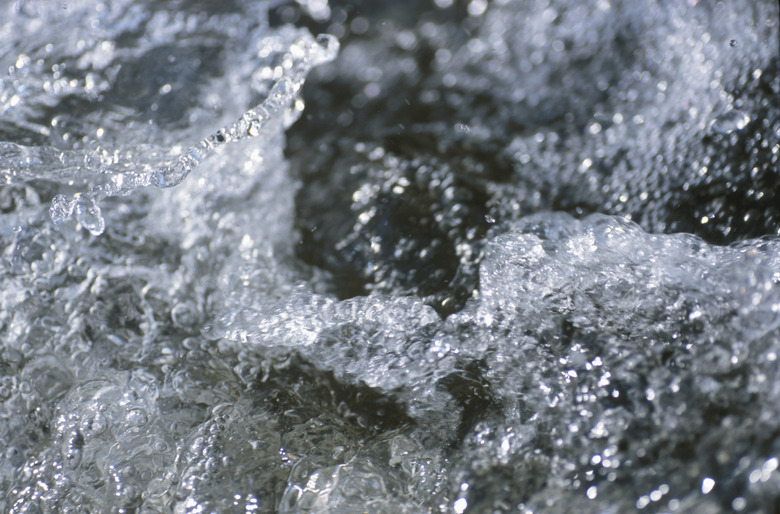How To Calculate Cubic Feet Per Second
The calculation of cubic feet per second (cfs) is relevant to water flow. It could be flowing through a pipe, along a riverbed or over a waterfall. HVAC pros measuring air flow through a duct system might also express the result in cubic feet per second, but cubic feet per minute is a more useful unit for measuring air flow.
Whether it's air flow or water flow you're measuring, you need two quantities to measure the flow rate. The first is the amount of air or water passing a particular point, which you can often determine by measuring the cross-sectional area A of the pipe, duct or riverbed. The second quantity is the velocity v of the air or water at that point. You may have to measure this directly, but in the case of water flowing through a pipe, you can calculate it using Poiseuille's law.
When you have these two quantities, you can immediately calculate flow rate Q, because
\(Q=Av\)
To get the result in cubic feet per second, you should use feet and seconds in your calculation. If you used other units in your flow rate calculator, you can always convert the result to cfs, but the procedure may be complicated.
Measuring Area for Your Flow Rate Calculator
Measuring Area for Your Flow Rate Calculator
When you're measuring flow rate through a closed pipe or duct system, and the fluid or gas fills the pipe or duct, you need only measure the dimensions to calculate area.
For a pipe, measure the diameter in feet, take half of that, which is the radius r, and use the formula
\(A=\pi r^2\)
For a rectangular duct, measure its width w and its height h in feet and multiply these together:
\(A = w\times h\)
To measure the cross-sectional area of a natural feature, such as a riverbed, you have to make some approximations. For example, you could assume the bed is a semicircular trough with a radius equal to the depth of the bed at its deepest point. Calculate area using A = πr2, then take half of that.
Measuring Velocity for Your CFS Calculator
Measuring Velocity for Your CFS Calculator
Measuring velocity can be more challenging, but not always. For example, in an open container, such as a riverbed, you can choose a point on the surface of the water and time how long it takes – in seconds – to pass two reference points separated by a certain number of feet. This gives you the velocity in feet per second.
If you're able to do this, it's easy to calculate flow rate in cubic feet per second. Just plug the numbers into the formula Q = A × v and you're done.
Using Poiseuille's Law
Using Poiseuille's Law
But what should you do about a closed pipe? If the pipe contains pressurized water, you can calculate flow rate using Poiseuille's law, as long as you can measure pressure at two different points in the pipe P1 and P2 in pounds per square foot (not pounds per square inch).
Convert if necessary using 1 pound per square foot (psf) = 0.0069 pounds per square inch (psi).
You also need the length of the pipe between those points L in feet and the radius of the pipe r in feet.
You also need the viscosity of water η at the current temperature. You can look that up. It must be expressed in pounds per foot second, but you usually find it expressed in centipoise. If that happens, you can convert using this factor: 1 centipoise = 6.72 x 10-4 pounds per foot second.
Once you have these quantities, find flow rate in cubic feet per second using this equation (Poiseuille's law):
\(Q = \frac{π(P_1- P_2)r^4}{8ηL}\)
Cite This Article
MLA
Deziel, Chris. "How To Calculate Cubic Feet Per Second" sciencing.com, https://www.sciencing.com/calculate-cubic-feet-per-second-6739627/. 21 December 2020.
APA
Deziel, Chris. (2020, December 21). How To Calculate Cubic Feet Per Second. sciencing.com. Retrieved from https://www.sciencing.com/calculate-cubic-feet-per-second-6739627/
Chicago
Deziel, Chris. How To Calculate Cubic Feet Per Second last modified March 24, 2022. https://www.sciencing.com/calculate-cubic-feet-per-second-6739627/
